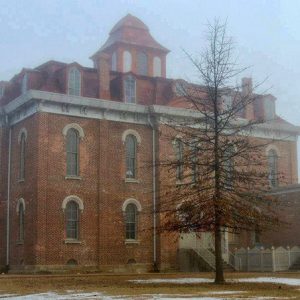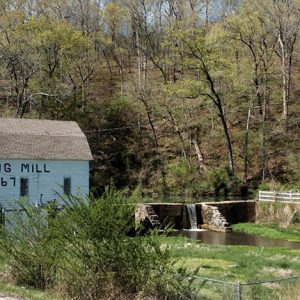calsfoundation@cals.org
John Adams Schnable (1817–1901)
Lieutenant Colonel John Adams Schnable was a noted Arkansas architect and engineer who designed and built Spring Mill and two rock bridges over Salado Creek in Independence County, as well as the Jacksonport (Jackson County) courthouse in Jackson County. He was a Civil War veteran and one of the few German immigrants who fought on the side of the Confederacy.
John Schnable (name spelling varies) was born on June 11, 1817, in the German Confederation shortly after its creation in 1815 by the Congress of Vienna. Researchers are unsure about the names of his parents. He was directly involved in the Revolution of 1848 and, as a result, migrated to the United States and arrived in Virginia in 1851, where the governor commissioned him captain in the Virginia militia. Captain Schnable and his troops helped restore order following the John Brown Raid at Harper’s Ferry in 1859.
As the clouds of war caused more tension in Virginia, Schnable moved west to Missouri, where he was contracted to build the city jail in Rolla. A few months after the beginning of the Civil War, Schnable became a member of the Missouri State Guard in Springfield in October 1861. In 1863, at age forty-six, he enlisted in the Confederate army at Yellville (Marion County) and served as a lieutenant colonel, Schnable’s Battalion, Missouri Cavalry. On the enlistment papers, Schnable is described as having blue eyes, light hair, dark complexion, and a height of six feet and one inch.
Col. Schnable earned the dubious distinction of being captured and put in the very jail in Rolla that he had built. Once released from jail, Schnable commanded a battalion in General Joseph Shelby’s Iron Brigade in the Battle of Helena on July 4, 1863. In 1864, the colonel recruited men from Lead Hill (Boone County) for his Missouri cavalry. He continued to fight until the end of the war, surrendering in the spring of 1865 at Jacksonport, where he decided to live. He became the proprietor of a brickyard with a brick kiln near the town square.
Schnable married fellow Virginian Sarah Elizabeth Chinn at Chinn Spring (Independence County) on May 10, 1866. Sarah was twice a widow, and she had four children when she married Schnable. The two had no children together but adopted a son, John A. Micklewright, listed on the 1900 census. Sarah Schnable was the daughter of Virginia-born John French Chinn, the founder of Chinn Spring and a prominent landowner in the area.
Schnable had received his training in engineering in the German Confederation and was in demand for his knowledge and skills during Reconstruction. In 1867, he was contracted to build a water-powered grist mill for Anthony N. Simmons in Independence County between Batesville (Independence County) and what is today Cushman (Independence County). The mill, called Spring Mill, had long been in a state of disrepair but was restored and renovated by its new owner in 2019. A memorial stone tablet beneath the millhouse reads: “Built for Anthony N. Simmons by Colonel John Schnabel October 18, 1867.” It was state-of-the-art, with imported millstones and a Leffel 40-horsepower vertical water turbine shipped from Ohio. The original building was made of hand-hewed logs fastened with wooden square nails. (In 1976, Ora Mae Stewart Lytle operated the mill to grind meal for distribution by the Bicentennial wagon train on its trip from Arkansas to Valley Forge, Pennsylvania.)
In 1869, a contract was awarded to Thomas Cox and Schnable for the construction of the Jacksonport courthouse using hand-pressed bricks from the Schnable kiln. Schnable suggested that the stone foundation be raised an additional two feet. This action probably saved the building several times against rising floodwaters. The two-story building, with its Second Empire architecture, was finished in 1872 at a cost of between $65,000 and $70,000 and turned over to the county. The courthouse fell into disrepair and was used as a cotton gin, as public housing for the homeless and elderly, and eventually by local farmers to store grain until an effort was begun to restore the building in 1962. Today, the historic building houses the Jacksonport State Park Museum.
In 1870, Schnable built two bridges of native sandstone set in mortar across Salado Creek in Independence County, one between Salado and Rosie and an identical one at what became Huff, between Southside and Pleasant Plains. The bridge at Huff collapsed from a flood in 1928 and the one at Salado/Rosie collapsed in 1958. The remains of both bridges are still visible in the twenty-first century. The old stone bridges were spandrel-arch structures with twin arches.
Schnable became active in state politics and, in 1891, was elected Jackson County representative in the Arkansas General Assembly, serving two years.
Sarah Schnable died on March 10, 1901, and Colonel Schnable died the next day on March 11, 1901. They were buried at the Patterson Minor Cemetery in Diaz (Jackson County). After the cemetery was abandoned and gradually returned to nature, their grave markers were moved to the Chinn Cemetery fourteen miles north of Batesville in Independence County, where Sarah’s family is buried. The original foot marker was left at Patterson Minor Cemetery.
In May 2017 at the Chinn Cemetery, a ceremony was held to bestow and dedicate a Southern Iron Cross of Honor for Lt. Col. Schnable by the United Daughters of the Confederacy, Sons of Confederate Veterans, and Military Order of the Stars and Bars.
For additional information:
“Builder of Spring Mill to be Honored.” Batesville Guard, May 2, 2017, pp. 1, 7.
Gibbs, Angela. “An Idea Is Born—The History of Jacksonport State Park, Part 1.” Stream of History 48 (September 2015): 3–8.
“Grave of a Builder.” Batesville Guard, May 15, 1956, p. 2.
Leone, Anthony. “Salado Bridge.” Arkansas Gazette Sunday Magazine, June 16, 1957, p. 1F.
McGinnis, A. C. “A History of Independence County, Ark.” Special issue. Independence County Chronicle 17 (April 1976).
Robertson, Brian K., and Nancy Britton. Independence County, Arkansas. Charleston, SC: Arcadia Publishing, 2001.
West, Mabel. “Jacksonport, Arkansas: Its Rise and Decline.” Arkansas Historical Quarterly 9 (Winter 1950): 231–233.
Kenneth Rorie
Van Buren, Arkansas
 Civil War through Reconstruction, 1861 through 1874
Civil War through Reconstruction, 1861 through 1874 Jacksonport State Park Museum
Jacksonport State Park Museum  Schnable Grave
Schnable Grave  Sarah Schnable Grave
Sarah Schnable Grave  Spring Mill
Spring Mill  Spring Mill Marker
Spring Mill Marker 




Comments
No comments on this entry yet.